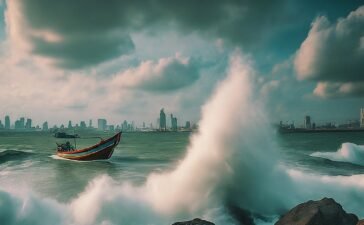Eight industrial estates and parks are in danger of being flooded, warns Industry Minister Wannarat Channukul.
They include Bang Chan and Lad Krabang in Bangkok, Bang Phli and Bang Poo in Samut Prakan, Kaeng Khoi in Saraburi, Hi-Tech in Ayutthaya, and Navanakorn and Bangkradee in Pathum Thani.
The earthen dyke of Hi-Tech Industrial Estate was leaking yesterday morning, but 150 soldiers and workers from the estate were able to keep water from entering the area.
The estate can withstand an additional rise of 50 centimetres in water levels, but the Industrial Estate Authority of Thailand (IEAT) has asked business operators to stop their operations and evacuate workers, raw materials and machinery from the area as a precaution. The water level is now 4.9 metres, a 20cm rise from two days ago.
Hi-Tech, a joint venture between the IEAT and the Thai Industrial Estate, houses 143 factories and 51,186 workers with 65.3 billion baht in investment.
The Factoryland Industrial Park, housing 99 small and medium enterprises in the electronics, plastics and metals sectors, can hold off an additional 70cm of water.
“However,” Mr Wannarat said, “the Irrigation Department has already lowered the flow of water from Pasak dam, from 750 cubic metres per second to 600, resulting in a lower amount of water flowing from Pasak to Ayutthaya, especially to the Wang Noi district.”
Nationwide, 930 factories in 27 provinces are affected by the floods, with the most damage in Ayutthaya, Lop Buri and Nakhon Sawan. Damage has been estimated at 26 billion baht, excluding Rojana Industrial Park.
“We are concerned about the Lad Krabang Industrial Estate, which could withstand another 56cm before flooding,” said the vice-minister for industry, Suparp Kleekhajai. “But the situation is not yet severe enough for us to ask them to close their factories.”
He said that Pang Pa-in, under Ch. Karnchang Plc, had plans in place including excavators, “which should make them okay”.
Pang Pa-in can withstand an additional 1.3-metres rise in water. The IEAT has asked businesses to stop operations, but some factories are carrying on anyway.
Suchada Kirakul, the Bank of Thailand deputy governor for monetary stability, said the flooding would affect manufacturing output significantly over the next few months, with rehabilitation spurring the economy in early 2012.
The government expects the disaster to cut 0.6 to 0.9 percentage points from economic growth this year, including damage to industrial estates and farmland.
Ms Suchada said the flooding impact on the economy would also reflect damage to factory machines and stockpiles.
“It remains difficult to assess the overall economic damage from the floods, as the situation has not stabilised,” she said.
“The economy will feel the impact most significantly in the fourth quarter of 2011. But we think rehabilitation after the water recedes could increase employment and economic activity in the first quarter of next year.”
Local banks are likely to restructure debt with their good borrowers to ease burdens from the floods, she added.
The central bank’s Monetary Policy Committee will meet Oct 19 to decide on the benchmark interest rate, currently 3.5%, amid general market expectation that it will be left unchanged.
Source: Bangkok Post





